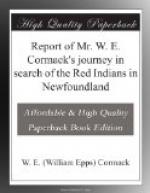This spot has been a favourite place of settlement with these people. It is situated at the commencement of a portage, which forms a communication by a path between the sea-coast at Badger Bay, about eight miles to the north-east, and a chain of lakes extending westerly and southerly from hence, and discharging themselves by a rivulet into the River Exploits, about thirty miles from its mouth. A path also leads from this place to the lakes, near New Bay, to the eastward. Here are the remains of one of their villages, where the vestiges of eight or ten winter mamateeks or wigwams, each intended to contain from six to eighteen or twenty people, are distinctly seen close together. Besides these, there are the remains of a number of summer wigwams. Every winter wigwam has close by it a small square-mouthed or oblong pit, dug into the earth, about four feet deep, to preserve their stores, &c. in. Some of these pits were lined with birch-rind. We discovered also in this village the remains of a vapour-bath. The method used by the Boeothicks to raise the steam, was by pouring water on large stones, made very hot for the purpose, in the open air, by burning a quantity of wood around them; after this process, the ashes were removed, and a hemispherical frame-work, closely covered with skins, to exclude the external air, was fixed over the stones. The patient then crept in under the skins, taking with him a birch-rind-bucket of water, and a small bark-dish to dip it out, which, by pouring on the stones, enabled him to raise the steam at pleasure[A].
At Hall’s Bay we got no useful information from the three (and the only) English families settled there. Indeed we could hardly have expected any; for these, and such people, have been the unchecked and ruthless destroyers of the tribe, the remnant of which we were in search of. After sleeping one night in a house, we again struck into the country to the westward.
In five days we were on the high lands south of White Bay, and in sight of the high lands east of the Bay of Islands, on the west coast of Newfoundland. The country south and west of us was low and flat, consisting of marshes, extending in a southerly direction more than thirty miles. In this direction lies the famous Red Indians’ Lake. It was now near the middle of November, and the winter had commenced pretty severely in the interior. The country was everywhere covered with snow, and, for some days past, we had walked over the small ponds on the ice. The summits of the hills on which we stood had snow on them, in some places many feet deep. The deer were migrating from the rugged and dreary mountains in the north to the low mossy barrens and more woody parts in the south; and we inferred, that if any of the Red Indians had been at White Bay during the past summer, they might be at that time stationed about the borders of the low tract of country before us, at the deer-passes, or were employed somewhere




